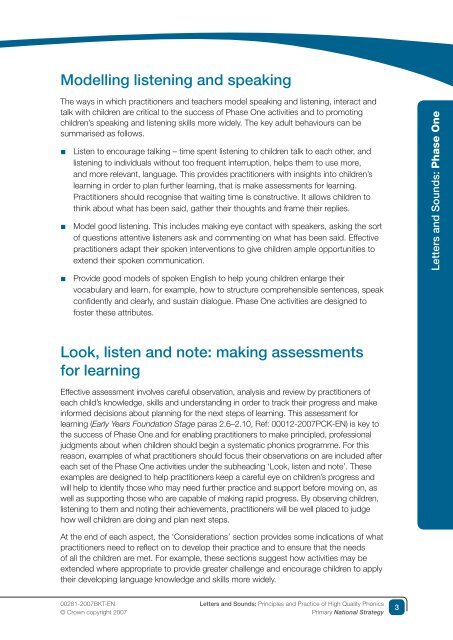Letters and Sounds 1
Letters and Sounds 1
Letters and Sounds 1
Create successful ePaper yourself
Turn your PDF publications into a flip-book with our unique Google optimized e-Paper software.
Modelling listening <strong>and</strong> speaking<br />
The ways in which practitioners <strong>and</strong> teachers model speaking <strong>and</strong> listening, interact <strong>and</strong><br />
talk with children are critical to the success of Phase One activities <strong>and</strong> to promoting<br />
children’s speaking <strong>and</strong> listening skills more widely. The key adult behaviours can be<br />
summarised as follows.<br />
■ Listen to encourage talking – time spent listening to children talk to each other, <strong>and</strong><br />
listening to individuals without too frequent interruption, helps them to use more,<br />
<strong>and</strong> more relevant, language. This provides practitioners with insights into children’s<br />
learning in order to plan further learning, that is make assessments for learning.<br />
Practitioners should recognise that waiting time is constructive. It allows children to<br />
think about what has been said, gather their thoughts <strong>and</strong> frame their replies.<br />
■ Model good listening. This includes making eye contact with speakers, asking the sort<br />
of questions attentive listeners ask <strong>and</strong> commenting on what has been said. Effective<br />
practitioners adapt their spoken interventions to give children ample opportunities to<br />
extend their spoken communication.<br />
■ Provide good models of spoken English to help young children enlarge their<br />
vocabulary <strong>and</strong> learn, for example, how to structure comprehensible sentences, speak<br />
confidently <strong>and</strong> clearly, <strong>and</strong> sustain dialogue. Phase One activities are designed to<br />
foster these attributes.<br />
Look, listen <strong>and</strong> note: making assessments<br />
for learning<br />
Effective assessment involves careful observation, analysis <strong>and</strong> review by practitioners of<br />
each child’s knowledge, skills <strong>and</strong> underst<strong>and</strong>ing in order to track their progress <strong>and</strong> make<br />
informed decisions about planning for the next steps of learning. This assessment for<br />
learning (Early Years Foundation Stage paras 2.6–2.10, Ref: 00012-2007PCK-EN) is key to<br />
the success of Phase One <strong>and</strong> for enabling practitioners to make principled, professional<br />
judgments about when children should begin a systematic phonics programme. For this<br />
reason, examples of what practitioners should focus their observations on are included after<br />
each set of the Phase One activities under the subheading ‘Look, listen <strong>and</strong> note’. These<br />
examples are designed to help practitioners keep a careful eye on children’s progress <strong>and</strong><br />
will help to identify those who may need further practice <strong>and</strong> support before moving on, as<br />
well as supporting those who are capable of making rapid progress. By observing children,<br />
listening to them <strong>and</strong> noting their achievements, practitioners will be well placed to judge<br />
how well children are doing <strong>and</strong> plan next steps.<br />
At the end of each aspect, the ‘Considerations’ section provides some indications of what<br />
practitioners need to reflect on to develop their practice <strong>and</strong> to ensure that the needs<br />
of all the children are met. For example, these sections suggest how activities may be<br />
extended where appropriate to provide greater challenge <strong>and</strong> encourage children to apply<br />
their developing language knowledge <strong>and</strong> skills more widely.<br />
00281-2007BKT-EN<br />
© Crown copyright 2007<br />
<strong>Letters</strong> <strong>and</strong> <strong>Sounds</strong>: Principles <strong>and</strong> Practice of High Quality Phonics<br />
Primary National Strategy<br />
<strong>Letters</strong> <strong>and</strong> <strong>Sounds</strong>: Phase One
















